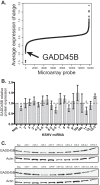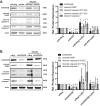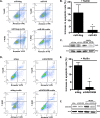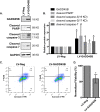Kaposi's Sarcoma-Associated Herpesvirus MicroRNAs Target GADD45B To Protect Infected Cells from Cell Cycle Arrest and Apoptosis
- PMID: 27852859
- PMCID: PMC5244352
- DOI: 10.1128/JVI.02045-16
Kaposi's Sarcoma-Associated Herpesvirus MicroRNAs Target GADD45B To Protect Infected Cells from Cell Cycle Arrest and Apoptosis
Abstract
Kaposi's sarcoma is one of the most common malignancies in HIV-infected individuals. The responsible agent, Kaposi's sarcoma-associated herpesvirus (KSHV; HHV8), expresses multiple microRNAs (miRNAs), but the targets and functions of these miRNAs are not completely understood. After infection in primary endothelial cells with KSHV, growth arrest DNA damage-inducible gene 45 beta (GADD45B) is one of the most repressed genes using genomic expression profiling. GADD45B was also repressed in mRNA expression profiling experiments when KSHV miRNAs were introduced to uninfected cells. We hypothesized that KSHV miRNAs target human GADD45B to protect cells from consequences of DNA damage, which can be triggered by viral infection. Expression of GADD45B protein is induced by the p53 activator, Nutlin-3, and KSHV miRNA-K9 inhibits this induction. In addition, Nutlin-3 increased apoptosis and cell cycle arrest based on flow cytometry assays. KSHV miR-K9 protected primary endothelial cells from apoptosis and cell cycle arrest following Nutlin-3 treatment. Similar protective phenotypes were seen for targeting GADD45B with short interfering RNAs (siRNAs), as with miR-K9. KSHV miR-K9 also decreased the protein levels of cleaved caspase-3, cleaved caspase-7, and cleaved poly(ADP-ribose) polymerase (PARP). In B lymphocytes latently infected with KSHV, specific inhibitors of KSHV miR-K9 led to increased GADD45B expression and apoptosis, indicating that miR-K9 is important for reducing apoptosis in infected cells. Furthermore, ectopic expression of GADD45B in KSHV-infected cells promoted apoptosis. Together, these results identify a new miRNA target and demonstrate that KSHV miRNAs are important for protecting infected cells from DNA damage responses.
Importance: Kaposi's sarcoma-associated herpesvirus is a leading cause of cancers in individuals with AIDS. Promoting survival of infected cells is essential for maintaining viral infections. A virus needs to combat various cellular defense mechanisms designed to eradicate the viral infection. One such response can include DNA damage response factors, which can promote an arrest in cell growth and trigger cell death. We used a new approach to search for human genes repressed by small nucleic acids (microRNAs) expressed by a gammaherpesvirus (KSHV), which identified a gene called GADD45B as a target of microRNAs. Repression of GADD45B, which is expressed in response to DNA damage, benefited survival of infected cells in response to a DNA damage response. This information could be used to design new treatments for herpesvirus infections.
Keywords: DNA damage; Kaposi's sarcoma-associated herpesvirus; cell cycle; microRNA.
Copyright © 2017 American Society for Microbiology.
Figures








Similar articles
-
KSHV microRNAs: Tricks of the Devil.Trends Microbiol. 2017 Aug;25(8):648-661. doi: 10.1016/j.tim.2017.02.002. Epub 2017 Mar 2. Trends Microbiol. 2017. PMID: 28259385 Free PMC article. Review.
-
Kaposi's sarcoma-associated herpesvirus microRNAs repress breakpoint cluster region protein expression, enhance Rac1 activity, and increase in vitro angiogenesis.J Virol. 2015 Apr;89(8):4249-61. doi: 10.1128/JVI.03687-14. Epub 2015 Jan 28. J Virol. 2015. PMID: 25631082 Free PMC article.
-
Modified Cross-Linking, Ligation, and Sequencing of Hybrids (qCLASH) Identifies Kaposi's Sarcoma-Associated Herpesvirus MicroRNA Targets in Endothelial Cells.J Virol. 2018 Mar 28;92(8):e02138-17. doi: 10.1128/JVI.02138-17. Print 2018 Apr 15. J Virol. 2018. PMID: 29386283 Free PMC article.
-
Viral MicroRNAs Repress the Cholesterol Pathway, and 25-Hydroxycholesterol Inhibits Infection.mBio. 2017 Jul 11;8(4):e00576-17. doi: 10.1128/mBio.00576-17. mBio. 2017. PMID: 28698273 Free PMC article.
-
Role of host microRNAs in Kaposi's sarcoma-associated herpesvirus pathogenesis.Viruses. 2014 Nov 21;6(11):4571-80. doi: 10.3390/v6114571. Viruses. 2014. PMID: 25421888 Free PMC article. Review.
Cited by
-
Druggable host gene dependencies in primary effusion lymphoma.Curr Opin Virol. 2022 Oct;56:101270. doi: 10.1016/j.coviro.2022.101270. Epub 2022 Sep 28. Curr Opin Virol. 2022. PMID: 36182745 Free PMC article. Review.
-
Viral miRNA regulation of host gene expression.Semin Cell Dev Biol. 2023 Sep 15;146:2-19. doi: 10.1016/j.semcdb.2022.11.007. Epub 2022 Nov 30. Semin Cell Dev Biol. 2023. PMID: 36463091 Free PMC article. Review.
-
The Oncogenic Kaposi's Sarcoma-Associated Herpesvirus Encodes a Mimic of the Tumor-Suppressive miR-15/16 miRNA Family.Cell Rep. 2019 Dec 3;29(10):2961-2969.e6. doi: 10.1016/j.celrep.2019.11.005. Cell Rep. 2019. PMID: 31801064 Free PMC article.
-
KSHV microRNAs: Tricks of the Devil.Trends Microbiol. 2017 Aug;25(8):648-661. doi: 10.1016/j.tim.2017.02.002. Epub 2017 Mar 2. Trends Microbiol. 2017. PMID: 28259385 Free PMC article. Review.
-
Herpes Simplex Virus 1 Deregulation of Host MicroRNAs.Noncoding RNA. 2018 Nov 23;4(4):36. doi: 10.3390/ncrna4040036. Noncoding RNA. 2018. PMID: 30477082 Free PMC article. Review.
References
-
- Gottwein E, Corcoran DL, Mukherjee N, Skalsky RL, Hafner M, Nusbaum JD, Shamulailatpam P, Love CL, Dave SS, Tuschl T, Ohler U, Cullen BR. 2011. Viral microRNA targetome of KSHV-infected primary effusion lymphoma cell lines. Cell Host Microbe 10:515–526. doi: 10.1016/j.chom.2011.09.012. - DOI - PMC - PubMed
MeSH terms
Substances
LinkOut - more resources
Full Text Sources
Other Literature Sources
Research Materials
Miscellaneous

